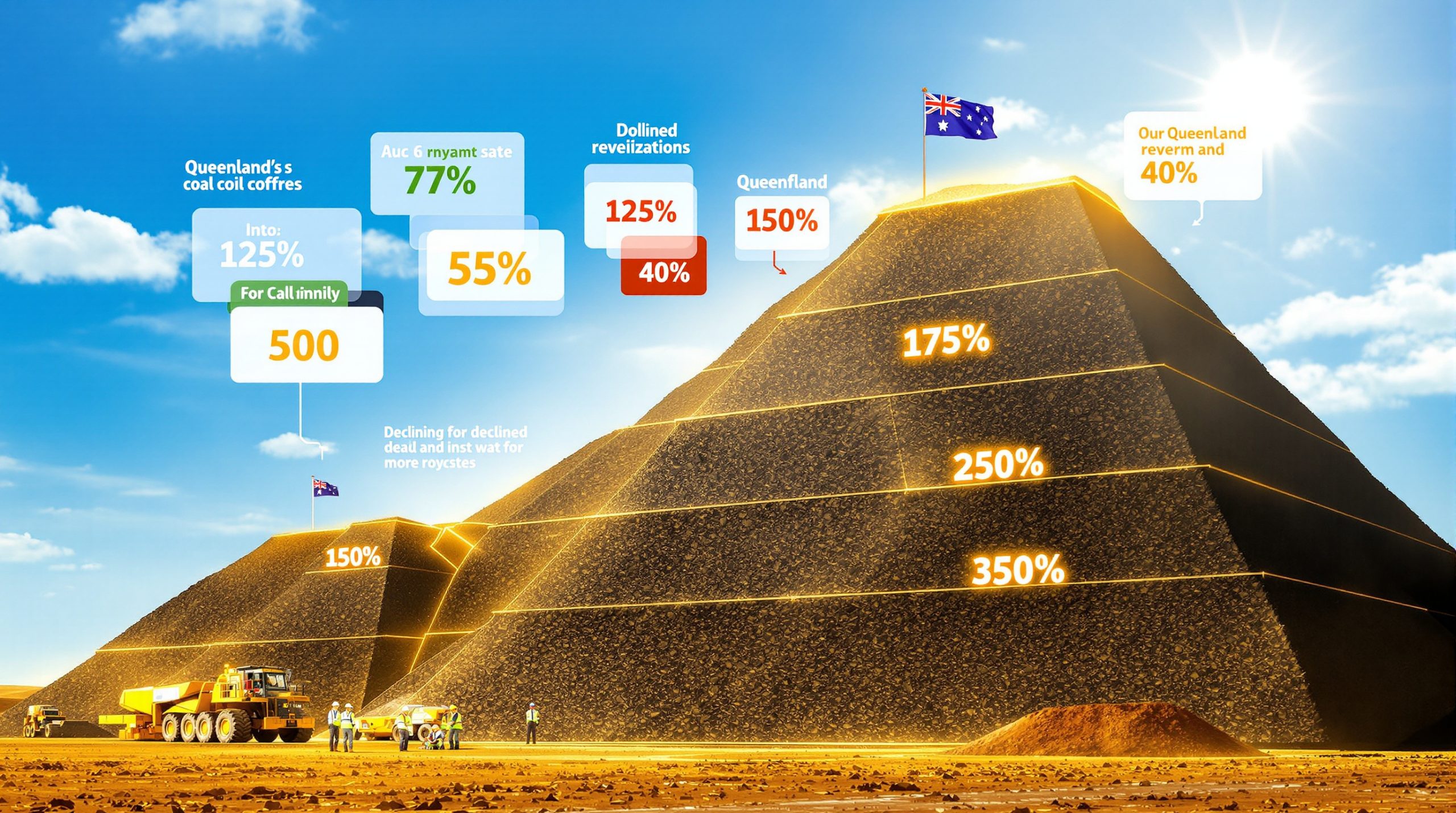Understanding Regis Resources' Record $254 Million Profit: Financial Analysis and Market Impact
Regis Resources has achieved a remarkable financial turnaround in FY25, posting a record $254 million net profit after tax compared to a $186 million loss in the previous year. This extraordinary shift represents a $440 million improvement in the company's bottom line, demonstrating the gold miner's operational resilience during a period of favorable gold prices.
Several factors contributed to this impressive performance, including a 47% gold price appreciation with an average realized price of $4,387 per ounce, a 30% increase in gold sales revenue reaching $1.65 billion, record underlying EBITDA of $780 million at a 47% margin, and strong operating cash flow of $821 million.
The significant profit turnaround has positioned Regis as one of the Australian gold sector's standout performers for FY25, though investors remain cautious about future operational challenges.
How Did Regis Strengthen Its Financial Position?
The Perth-based gold producer has significantly transformed its balance sheet during FY25, implementing a disciplined capital management strategy that positions the company for future growth and shareholder returns.
Key financial achievements include complete elimination of debt through a $300 million repayment, accumulation of $517 million in cash and bullion reserves at year-end, declaration of a fully franked final dividend of 5 cents per share, and total shareholder returns since 2013 reaching $585 million.
This financial strengthening demonstrates management's commitment to maintaining a robust balance sheet while still delivering value to shareholders through consistent dividend payments. The debt-free status gives Regis considerable flexibility to pursue growth opportunities or weather potential market volatility.
"In FY26 we will stay focused on reliable, consistent and safe production with cost discipline," stated Managing Director Jim Beyer, highlighting the company's operational priorities moving forward.
What Challenges Does Regis Face Despite Record Profits?
Despite the impressive profit figures, Regis Resources faces several operational headwinds that have concerned investors and contributed to share price weakness following the results announcement.
Production and Cost Outlook
The company's FY26 guidance reveals some challenging trends:
- Production target of 350,000-380,000 ounces, potentially lower than FY25 levels
- All-in sustaining cost (AISC) guidance of $2,610-$2,990 per ounce
- Non-cash stockpile draw contributing $170 per ounce to costs
- Growth capital expenditure expected at $180-195 million
These metrics suggest Regis may face margin pressure in the coming year despite the current strong gold market surge, with production volumes potentially declining while costs increase.
Market Response
The market reaction to Regis' results highlights investor concerns:
- Share price declined over 7% following the announcement
- Stock has retreated approximately 30% from June 2025 highs
- Profit figures came in approximately 8% below analyst consensus
- Revenue slightly missed market expectations
This negative response suggests investors are focusing more on future cost pressures and production challenges than on the historic profit achievement. The market appears to be looking beyond the headline profit number to assess the company's longer-term operational trajectory.
What's Behind the Gold Price Rally Benefiting Regis?
The extraordinary gold price environment has been a crucial factor in Regis' financial performance. Understanding the macroeconomic drivers helps contextualize the company's results.
Gold has experienced a strong rally throughout FY25, driven by:
- Global economic uncertainties driving safe-haven demand
- Geopolitical tensions supporting precious metals prices
- Central bank gold purchases at historically high levels
- Inflation concerns prompting investor hedging strategies
These factors combined to push gold prices to record levels, significantly boosting Regis' revenue and profitability despite operational challenges. The average realized gold price of $4,387 per ounce represents a 47% increase compared to the previous financial year.
Industry analysts note that the strong gold price forecast has masked some of the operational challenges facing many Australian gold producers, including rising costs across labor, energy, and consumables.
How Do Regis' Operations Compare to Industry Peers?
Contextualizing Regis' performance within the broader Australian gold mining sector provides valuable perspective on the company's competitive position and operational efficiency.
| Company | FY25 Production (oz) | AISC (A$/oz) | Net Profit (A$M) | Debt Position |
|---|---|---|---|---|
| Regis Resources | 350,000-380,000 (FY26 guidance) | $2,610-$2,990 | $254 | Debt-free |
| Northern Star | ~1.6 million | ~$1,900-2,000 | >$800 (est.) | Low leverage |
| Evolution Mining | ~720,000 | ~$1,800-1,900 | ~$300 (est.) | Moderate debt |
| Gold Road Resources | ~300,000 | ~$1,700-1,800 | ~$150 (est.) | Minimal debt |
This comparison highlights that while Regis has achieved impressive profit growth, its cost structure remains higher than some peers, potentially explaining investor concerns despite the record profit. The AISC guidance of $2,610-$2,990 per ounce positions Regis in the higher-cost segment of Australian gold producers.
The company's production scale is moderate compared to larger peers like Northern Star and Evolution Mining, though its debt-free status provides a competitive advantage in terms of balance sheet strength.
What Are Regis' Key Mining Operations?
Regis Resources operates two primary mining centers that contribute to its gold production, each with distinct operational characteristics and challenges.
Duketon Operations
Located in Western Australia's northeastern Goldfields, this operation includes:
- Multiple open pit mines with varying ore grades
- Processing facilities with significant throughput capacity
- Ongoing exploration to extend mine life and improve resource quality
- Historical production challenges that have impacted costs
The Duketon operations represent Regis' foundation asset and continue to be a significant contributor to overall production. However, these operations have faced increasing cost pressures and ore grade variability in recent years.
Tropicana Joint Venture
This significant operation in Western Australia's eastern Goldfields features:
- Partnership with a major mining company
- Combination of open pit and underground mining
- Substantial production contribution to Regis' portfolio
- Strategic importance for future growth
The Tropicana Joint Venture provides Regis with exposure to a world-class gold asset, though the company must coordinate development and operational decisions with its joint venture partner.
Both operations face ongoing cost pressures typical in the Australian mining sector outlook, including labor constraints, energy costs, and operational challenges related to mining deeper and more complex ore bodies.
What Is Regis' Strategy for FY26 and Beyond?
Managing Director Jim Beyer outlined the company's strategic focus for the coming year, emphasizing operational discipline and value creation.
Key elements of Regis' forward strategy include:
- Maintaining "reliable, consistent and safe production"
- Implementing disciplined cost management across operations
- Leveraging the strong balance sheet for growth opportunities
- Continuing exploration to extend mine life at key assets
- Balancing operational improvements with shareholder returns
The company's ability to execute this strategy while managing rising costs will be crucial for rebuilding investor confidence after the recent share price decline. With a debt-free balance sheet and substantial cash reserves, Regis has financial flexibility to pursue organic growth or potential acquisitions.
Industry analysts note that Regis' focus on cost discipline will be particularly important given the current inflationary environment in the Australian mining sector, where labor, energy, and consumable costs continue to rise.
How Might Gold Price Movements Impact Regis' Future Performance?
The sensitivity of Regis' financial results to gold price movements creates both opportunities and risks for the company and its shareholders.
Upside Potential
- Further gold price appreciation could offset production challenges
- Strong cash generation supporting increased shareholder returns
- Potential for accelerated debt-free growth initiatives
- Ability to fund exploration and mine life extensions
With its relatively high cost structure, Regis stands to benefit significantly from any additional strength in gold prices, as each dollar increase in the gold price flows directly to the bottom line.
Downside Risks
- Gold price correction could significantly impact margins
- Higher cost structure creates vulnerability compared to lower-cost producers
- Production variability may amplify negative price impacts
- Capital expenditure requirements could limit financial flexibility
This gold price sensitivity underscores the importance of Regis' focus on cost management and operational discipline. At current gold prices, the company's operations remain comfortably profitable, but any significant price correction would compress margins more quickly than for lower-cost producers.
Financial analysts estimate that each $100 change in the gold price can impact Regis' annual revenue by approximately $35-40 million based on current production levels.
What Investment Considerations Should Shareholders Evaluate?
For investors assessing Regis Resources' outlook following these results, several key factors warrant consideration when making investment decisions.
Critical evaluation points include:
- The sustainability of current gold prices and their impact on future profitability
- Management's ability to control rising costs across operations
- Production consistency and reliability in meeting guidance targets
- Balance sheet strength as a buffer against potential market volatility
- Dividend sustainability in various gold price scenarios
- Growth capital allocation and return on investment metrics
- Exploration success in extending mine life at key assets
These considerations highlight the complex interplay between operational execution, commodity prices, and shareholder returns that will determine Regis' future performance. Investors should consider their own gold price analysis when evaluating the company, as this remains the most significant driver of financial results.
The company's debt-free status and strong cash position provide a solid foundation, but operational execution will be key to delivering shareholder value in FY26 and beyond, according to a recent Kalgoorlie Miner report.
FAQ: Key Questions About Regis Resources' Financial Performance
Why did Regis Resources' share price fall despite record profits?
Investors appeared more concerned with forward-looking indicators like rising costs and potentially lower production guidance than with the historic profit achievement. The market often focuses on future prospects rather than past performance, and the guidance for FY26 suggests margin pressure despite current strong gold prices.
How sustainable is Regis' dividend policy?
With a debt-free balance sheet and strong cash position, Regis has capacity to maintain dividends, though future payments will depend on gold price movements, production performance, and capital requirements for growth initiatives. The current dividend represents a modest payout ratio that appears sustainable even if gold prices moderate somewhat.
What are the main cost pressures affecting Regis' operations?
Like many Australian miners, Regis faces rising labor costs in a tight mining labor market, energy price increases affecting processing operations, supply chain pressures on equipment and consumables, and the operational challenges of maintaining production from maturing assets with changing ore characteristics.
How does Regis' cost position compare to industry benchmarks?
Regis' AISC guidance of $2,610-$2,990 per ounce positions the company in the higher-cost segment of Australian gold producers, creating margin pressure despite strong gold prices. Most tier-one Australian gold producers operate with AISC in the $1,700-2,200 per ounce range, giving them greater margin protection against potential gold price volatility.
What growth opportunities could Regis pursue with its strengthened balance sheet?
With substantial cash reserves and no debt, Regis could consider brownfield expansions at existing operations, strategic acquisitions of complementary assets in Western Australia, or accelerated exploration programs to extend mine life and improve resource quality at current operations.
The company's strong financial position provides flexibility to pursue opportunities without relying on debt financing, an advantage in the current rising interest rate environment. As gold stocks analysis suggests, this could position Regis favorably compared to more leveraged competitors.
Want to Capitalise on the Next Major Mineral Discovery?
Discover why historic discoveries like De Grey Mining can generate substantial returns by exploring Discovery Alert's dedicated discoveries page, where our proprietary Discovery IQ model instantly alerts investors to significant ASX mineral discoveries, turning complex data into actionable insights.




